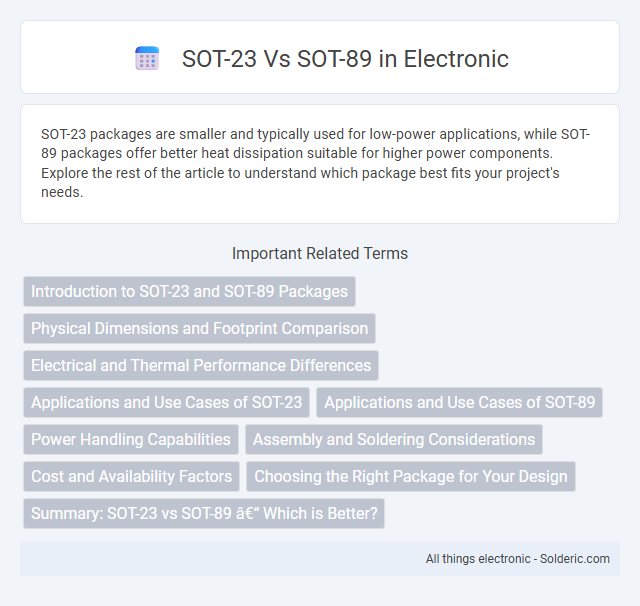SOT-23 packages are smaller and typically used for low-power applications, while SOT-89 packages offer better heat dissipation suitable for higher power components. Explore the rest of the article to understand which package best fits your project's needs.
Comparison Table
| Feature | SOT-23 | SOT-89 |
|---|---|---|
| Package Type | Small Outline Transistor, 3 leads | Small Outline Transistor, 3 leads |
| Body Size (mm) | 2.9 x 1.3 x 1.1 | 4.5 x 3.4 x 1.5 |
| Lead Pitch | 0.95 mm | 1.9 mm |
| Thermal Resistance (Typical) | Up to 200 degC/W | Approx. 50-70 degC/W |
| Power Dissipation | Up to ~350 mW | Up to ~1.2 W |
| Common Applications | Low power transistors, small signal switching | Medium power transistors, voltage regulators, power switches |
| Mounting Type | Surface-mount device (SMD) | Surface-mount device (SMD) |
| Typical Use Case | Compact circuits with limited power needs | Circuits requiring better heat dissipation |
Introduction to SOT-23 and SOT-89 Packages
SOT-23 and SOT-89 are popular semiconductor packaging types designed for surface-mount technology applications, offering compact size and efficient heat dissipation. SOT-23 is smaller, typically used for low-power devices such as transistors and diodes, while SOT-89 provides a larger thermal pad for higher power components, improving heat management. Choosing the right package impacts Your circuit's performance by balancing size constraints with thermal requirements.
Physical Dimensions and Footprint Comparison
The SOT-23 package measures approximately 2.9mm x 1.3mm, offering a compact footprint suitable for high-density PCB designs, whereas the SOT-89 package is larger at about 4.5mm x 3.7mm, providing increased power dissipation capabilities. SOT-23's smaller size benefits applications requiring minimal board space, while SOT-89's dimensions support devices with higher current and thermal requirements. PCB footprint differences impact component placement and thermal management strategies in electronic circuit design.
Electrical and Thermal Performance Differences
SOT-89 offers superior thermal performance compared to SOT-23, with a larger copper pad area enabling better heat dissipation and lower junction temperatures during high-power applications. Electrically, SOT-89 packages typically support higher current ratings and improved power handling due to their enhanced thermal capabilities, making them suitable for voltage regulators and power transistors. In contrast, SOT-23 is optimized for lower power, compact, and surface-mount applications with limited electrical load and thermal management requirements.
Applications and Use Cases of SOT-23
SOT-23 packages are widely used in compact applications like mobile devices, sensors, and small signal transistors due to their minimal footprint and ease of automated assembly. Your circuit benefits from SOT-23's ability to fit into tight spaces while delivering reliable performance in low-power applications. Compared to SOT-89, which suits higher power components like voltage regulators, SOT-23 is preferred for signal-level components in consumer electronics and portable devices.
Applications and Use Cases of SOT-89
SOT-89 packages are widely used in power regulation circuits, automotive electronics, and voltage regulators due to their superior thermal performance compared to SOT-23. SOT-23 packages are ideal for signal-level components in compact, low-power applications like mobile devices and sensor interfaces, while SOT-89 supports higher power dissipation, making it suitable for linear regulators and power transistors. Your choice should consider the required power handling and thermal management, with SOT-89 preferred for applications demanding higher current capacity and heat dissipation.
Power Handling Capabilities
SOT-89 packages provide superior power handling capabilities compared to SOT-23 due to their larger size and better thermal dissipation features, supporting power levels up to around 2-3 watts. SOT-23, being more compact, is typically limited to lower power applications, often under 0.5 watts, making it suitable for low-power signal devices. Your choice between these packages should depend on the thermal and power requirements of your specific electronic design.
Assembly and Soldering Considerations
SOT-23 packages offer a smaller footprint and finer pitch, requiring precise soldering techniques such as controlled reflow and careful thermal profiling to prevent solder bridging and ensure reliable joint formation. In contrast, the larger SOT-89 package provides easier handling and soldering with less risk of thermal damage due to its increased lead area and better heat dissipation, making assembly more forgiving for manual or wave soldering processes. Your choice between SOT-23 and SOT-89 should consider the balance between space constraints and the soldering method available in your manufacturing environment.
Cost and Availability Factors
SOT-23 packages typically offer lower cost due to widespread use in consumer electronics and higher manufacturing volumes, making them readily available from multiple suppliers. SOT-89 components, while offering better thermal performance, often come at a higher price point and may have slightly limited availability depending on specific semiconductor types. You can optimize your project budget by selecting SOT-23 devices where cost efficiency and abundant supply are critical.
Choosing the Right Package for Your Design
Choosing the right package between SOT-23 and SOT-89 depends on your design's power dissipation and space constraints. SOT-23 offers a compact footprint ideal for low-power applications, while SOT-89 handles higher power due to its larger size and better thermal performance. Evaluating thermal requirements and board space will help optimize your design efficiency and reliability.
Summary: SOT-23 vs SOT-89 – Which is Better?
SOT-23 and SOT-89 are popular semiconductor packages, with SOT-23 favored for compact, low-power applications due to its small size and three leads, providing cost-effective integration in dense circuit boards. SOT-89 offers superior thermal performance and higher power dissipation capabilities, making it ideal for power transistors and voltage regulators where heat management is critical. Choosing between SOT-23 and SOT-89 depends on the application requirements for power handling, size constraints, and thermal management efficiency.
SOT-23 vs SOT-89 Infographic

 solderic.com
solderic.com